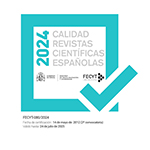Caracterización del viento local en la morfología del centro histórico de Quito, Ecuador
Resumen
El viento local incide en el microclima urbano, en donde los edificios causan que el viento pierda intensidad al llegar a calles y plazas, afectando la ventilación y el confort peatonal. El presente estudio tiene por objeto evaluar el comportamiento del viento peatonal empleando morfometría, mecánica de fluidos computacional (CFD) e indicadores de ventilación para un área del centro histórico de Quito en un radio de 400 m. El modelo presenta cañones urbanos con orientaciones respecto al norte de 40° y 125°. Los cañones se modelan en base a su geometría para definir el ratio H/W. Posteriormente, se realizan simulaciones considerando el viento prevalente de la zona durante los periodos de día (6:00- 12:00) y tarde (12:00-18:00). Las simulaciones muestran una velocidad de viento peatonal entre 0,8 y 1,2 m/s, que ocasiona una reducción térmica de 2°C. Además, los indicadores de ventilación muestran un mejor comportamiento para los cañones menos profundos.
Descargas
Descarga artículo
Licencia
La revista Anales de Geografía de la Universidad Complutense, para fomentar el intercambio global del conocimiento, facilita el acceso sin restricciones a sus contenidos desde el momento de su publicación en la presente edición electrónica, y por eso es una revista de acceso abierto. Los originales publicados en esta revista son propiedad de la Universidad Complutense de Madrid y es obligatorio citar su procedencia en cualquier reproducción total o parcial. Todos los contenidos se distribuyen bajo una licencia de uso y distribución Creative Commons Reconocimiento 4.0 (CC BY 4.0). Esta circunstancia ha de hacerse constar expresamente de esta forma cuando sea necesario. Puede consultar la versión informativa y el texto legal de la licencia.












